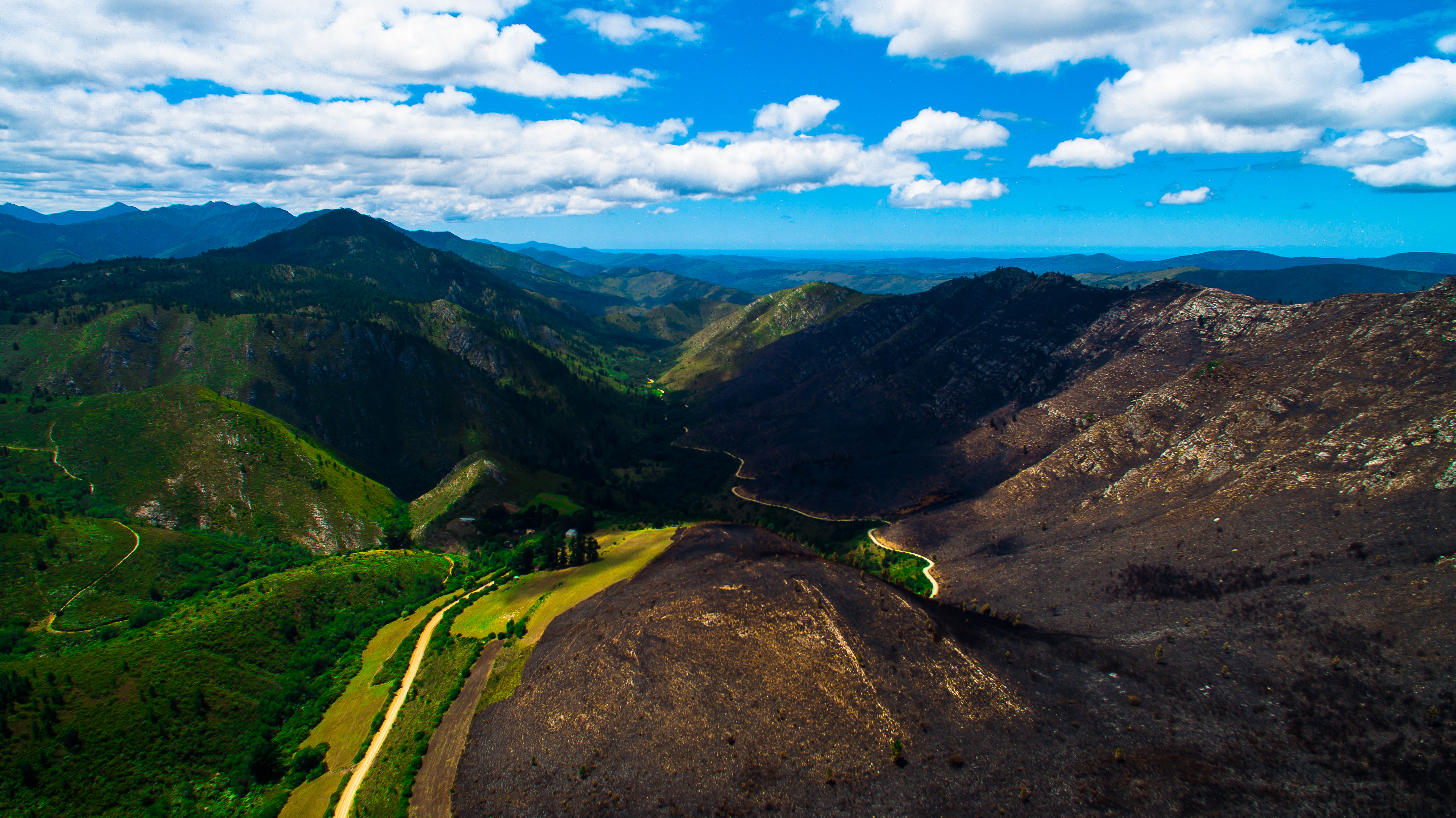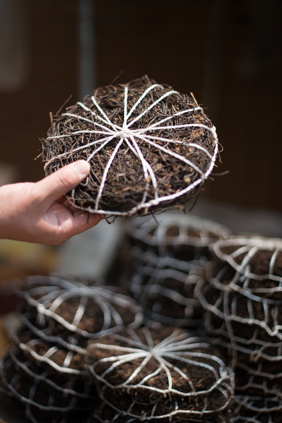|
Cyclic Succession
Cyclic succession is a pattern of vegetation change in which in a small number of species tend to replace each other over time in the absence of large-scale disturbance. Observations of cyclic replacement have provided evidence against traditional Clementsian views of an end-state climax community with stable species compositions. Cyclic succession is one of several kinds of ecological succession, a concept in community ecology. When used narrowly, 'cyclic succession' refers to processes not initiated by wholesale exogenous disturbances or long-term physical changes in the environment. However, broader cyclic processes can also be observed in cases of secondary succession in which regular disturbances such as insect outbreaks can 'reset' an entire community to a previous stage. These examples differ from the classic cases of cyclic succession discussed below in that entire species groups are exchanged, as opposed to one species for another. On geologic time scales, climat ... [...More Info...] [...Related Items...] OR: [Wikipedia] [Google] [Baidu] |
Disturbance (ecology)
In ecology, a disturbance is a temporary change in environmental conditions that causes a pronounced change in an ecosystem. Disturbances often act quickly and with great effect, to alter the physical structure or arrangement of biotic and abiotic elements. A disturbance can also occur over a long period of time and can impact the biodiversity within an ecosystem. Major ecological disturbances may include fires, flooding, storms, insect outbreaks and trampling. Earthquakes, various types of volcanic eruptions, tsunami, firestorms, impact events, climate change, and the devastating effects of human impact on the environment ( anthropogenic disturbances) such as clearcutting, forest clearing and the introduction of invasive species can be considered major disturbances. Not only invasive species can have a profound effect on an ecosystem, but also naturally occurring species can cause disturbance by their behavior. Disturbance forces can have profound immediate effects on ecosys ... [...More Info...] [...Related Items...] OR: [Wikipedia] [Google] [Baidu] |
Ecological Facilitation
Ecological facilitation or probiosis describes species interactions that benefit at least one of the participants and cause harm to neither.Stachowicz, J. J. 2001. Mutualism, facilitation, and the structure of ecological communities. BioScience 51: 235-246. Facilitations can be categorized as mutualisms, in which both species benefit, or commensalisms, in which one species benefits and the other is unaffected.Boucher, D. H., S. James, and K. H. Keeler. 1982. The ecology of mutualism. Annual Review of Ecology and Systematics 13: 315-347.Callaway, R. M. 1995. Positive interactions among plants (Interpreting botanical progress). The Botanical Review 61: 306-349.Bruno, J. F., J. J. Stachowicz, and M. D. Bertness. 2003. Inclusion of facilitation into ecological theory. TREE 18: 119-125.Tirado, R. and F. I. Pugnaire. 2005. Community structure and positive interactions in constraining environments. OIKOS 111: 437-444. This article addresses both the mechanisms of facilitation and the incr ... [...More Info...] [...Related Items...] OR: [Wikipedia] [Google] [Baidu] |
Bracken
Bracken (''Pteridium'') is a genus of large, coarse ferns in the family (biology), family Dennstaedtiaceae. Ferns (Pteridophyta) are vascular plants that have alternating generations, large plants that produce spores and small plants that produce gamete, sex cells (eggs and sperm). Brackens are noted for their large, highly divided leaves. They are found on all continents except Antarctica and in all environments except deserts, though their typical habitat is moorland. The genus probably has the widest distribution of any fern in the world. The word ''bracken'' is of Old Norse origin, related to Swedish ''bräken'' and Danish ''bregne'', both meaning fern. In the past, the genus was commonly treated as having only one species, ''Pteridium aquilinum'', but the recent trend is to subdivide it into about ten species. Like other ferns, brackens do not have seeds or fruits, but the immature fronds, known as ''fiddleheads'', are sometimes eaten, although some are #Toxicity, thought ... [...More Info...] [...Related Items...] OR: [Wikipedia] [Google] [Baidu] |
Eddy Van Der Maarel
Evert "Eddy" van der Maarel (23 February 1934 – 4 April 2021) was a Dutch ecologist. He spent most of his career as professor of ecological botany at Uppsala University in Sweden. Career Van der Maarel was born on 23 February 1934 in Amsterdam. He studied biology at the University of Amsterdam between 1951 and 1959. Between 1962 and 1968 he worked at the institute of botany of Utrecht University and later at the institute of plant ecology of the University of Groningen. Van der Maarel obtained his PhD at Utrecht University in 1966 with a dissertation titled : "Over vegetatiestructuren, -relaties en -systemen in het bijzonder in de duingraslanden van Voorne". Between 1968 and 1981 he was a lecturer of geobotany at the Catholic University Nijmegen. From 1981 to 1999 van de Maarel was a professor of ecological botany at Uppsala University. From 1995 to 1999 he was the Gerard Baerends professor at the University of Groningen. He retired in 1999. He died on 4 April 2021. He was the ... [...More Info...] [...Related Items...] OR: [Wikipedia] [Google] [Baidu] |
Plant Sociology
Phytosociology, also known as phytocoenology or simply plant sociology, is the study of groups of species of plant that are usually found together. Phytosociology aims to empirically describe the vegetative environment of a given territory. A specific community of plants is considered a social unit, the product of definite conditions, present and past, and can exist only when such conditions are met. In phyto-sociology, such a unit is known as a phytocoenosis (or phytocoenose). A phytocoenosis is more commonly known as a plant community, and consists of the sum of all plants in a given area. It is a subset of a biocoenosis, which consists of all organisms in a given area. More strictly speaking, a phytocoenosis is a set of plants in area that are interacting with each other through competition or other ecological processes. Coenoses are not equivalent to ecosystems, which consist of organisms and the physical environment that they interact with. A phytocoensis has a distribution wh ... [...More Info...] [...Related Items...] OR: [Wikipedia] [Google] [Baidu] |
Life History Theory
Life history theory is an analytical frameworkVitzthum, V. (2008). Evolutionary models of women's reproductive functioning. ''Annual Review of Anthropology'', ''37'', 53-73 designed to study the diversity of life history strategies used by different organisms throughout the world, as well as the causes and results of the variation in their life cycles.Flatt, T., & Heyland, A. (Eds.). (2011). Mechanisms of Life History Evolution : The Genetics and Physiology of Life History Traits and Trade-Offs. Oxford, GB: OUP Oxford. It is a theory of biological evolution that seeks to explain aspects of organisms' anatomy and behavior by reference to the way that their life histories—including their reproductive development and behaviors, post-reproductive behaviors, and lifespan (length of time alive)—have been shaped by natural selection. A life history strategy is the "age- and stage-specific patterns" and timing of events that make up an organism's life, such as birth, weaning, maturation, ... [...More Info...] [...Related Items...] OR: [Wikipedia] [Google] [Baidu] |
Endogeny
Endogenous substances and processes are those that originate from within a living system such as an organism, tissue, or cell. In contrast, exogenous substances and processes are those that originate from outside of an organism. For example, estradiol is an endogenous estrogen hormone produced within the body, whereas ethinylestradiol is an exogenous synthetic estrogen, commonly used in birth control pills Oral contraceptives, abbreviated OCPs, also known as birth control pills, are medications taken by mouth for the purpose of birth control. Female Two types of female oral contraceptive pill, taken once per day, are widely available: * The combin .... References External links *{{Wiktionary-inline, endogeny Biology ... [...More Info...] [...Related Items...] OR: [Wikipedia] [Google] [Baidu] |
Dominance (ecology)
Ecological dominance is the degree to which one or several species have a major influence controlling the other species in their ecological community (because of their large size, population, productivity, or related factors) or make up more of the biomass. Most ecological communities are defined by their dominant species. *In many examples of wet woodland in western Europe, the dominant tree is alder (''Alnus glutinosa''). *In temperate bogs, the dominant vegetation is usually species of ''Sphagnum'' moss. * Tidal swamps in the tropics are usually dominated by species of mangrove (''Rhizophoraceae'') *Some sea floor communities are dominated by brittle stars. *Exposed rocky shorelines are dominated by sessile organisms such as barnacles and limpets. See also * National Vegetation Classification, a system for classifying British plant communities by their dominant species * Monodominance Monodominance is an ecological condition in which more than 60% of the tree canopy c ... [...More Info...] [...Related Items...] OR: [Wikipedia] [Google] [Baidu] |
Shade Tolerance
In ecology, shade tolerance is a plant's ability to tolerate low light levels. The term is also used in horticulture and landscaping, although in this context its use is sometimes imprecise, especially in labeling of plants for sale in commercial nurseries. Shade tolerance is a complex, multi-faceted property of plants. Different plant species exhibit different adaptations to shade, and a particular plant can exhibit varying degrees of shade tolerance, or even of requirement for light, depending on its history or stage of development. Basic concepts Except for some parasitic plants, all land plants need sunlight to survive. However, in general, more sunlight does not always make it easier for plants to survive. In direct sunlight, plants face desiccation and exposure to UV rays, and must expend energy producing pigments to block UV light, and waxy coatings to prevent water loss. Plants adapted to shade have the ability to use far-red light (about 730 nm) more effectivel ... [...More Info...] [...Related Items...] OR: [Wikipedia] [Google] [Baidu] |
Ecological Inhibtion
Ecology () is the study of the relationships between living organisms, including humans, and their physical environment. Ecology considers organisms at the individual, population, community, ecosystem, and biosphere level. Ecology overlaps with the closely related sciences of biogeography, evolutionary biology, genetics, ethology, and natural history. Ecology is a branch of biology, and it is not synonymous with environmentalism. Among other things, ecology is the study of: * The abundance, biomass, and distribution of organisms in the context of the environment * Life processes, antifragility, interactions, and adaptations * The movement of materials and energy through living communities * The successional development of ecosystems * Cooperation, competition, and predation within and between species * Patterns of biodiversity and its effect on ecosystem processes Ecology has practical applications in conservation biology, wetland management, natural resource management ( ... [...More Info...] [...Related Items...] OR: [Wikipedia] [Google] [Baidu] |





.jpg)